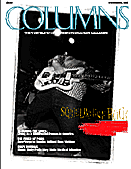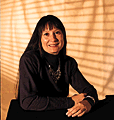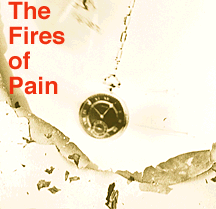

The actual name of the program was "Four More Bands, Four More Bucks," not "Four Bands for a Buck." As stated in the article, Nirvana did damage their own instruments; however, the article claims they also destroyed the HUB's PA system. The sound system used was not the HUB's but was rented from Seismic Audio. A former staff member has a memory of a HUB speaker being knocked off the stage which resulted in some minor damage. I have been unable to locate any record in our night logs or corresponsdence files regarding this incident. Also, it is not clear whether the speaker was knocked over by a member of Nirvana or by one of the more exuberant attendees.
As a staff member at this time, I cannot recall any discussions nor can I locate any correspondence about the banning of Nirvana or any of the other bands that played that evening (Skin Yard, Girl Trouble, The Fluid). There was some discussion regarding the stage diving that occurred as part of this event, as well as at some of the prior HUB concerts, and we did suspend bookings for a short period of time. The issue was resolved once we determined procedures which provided reasonable safety and security.
Paul Zuchowski
Asst. Director of Operations
Husky Union
Building
Editor's note: Paul Zuchowski is gathering memories, experiences or anecdotes about the HUB Building for a project that will celebrate the 50th anniversary of the HUB in October 1999. Please send all items to him at Box 352230, University of Washington, Seattle, WA 98195-2230; send e-mail to badgers@u.washington.edu.
While many Americans appear to have forgotten that we still have soldiers here, those who follow these things will know that about 18,000 us, predominantly from the 1st Armored Division, are still conducting peace enforcement operations. Through several significant incidents of non-compliance with the Dayton Peace Accords and the national elections in September, we continue to walk a fine line between encouraging peace, democracy and economic growth--and the forceful implementation of the accords.

We work closely with the militaries of the former warring factions, assisting them in removing mines, demilitarizing the zone of separation and developing militaries that support democracy. But we are also constantly prepared to use our tremendous firepower to ensure compliance. So far our mission has been tremendously successful. This is due to the superb efforts of our soldiers and the quality of our force in terms of training, equipment and professionalism.
While I personally do not believe that long-term peace is possible without the long-term presence of a significant enforcement force, it has been very encouraging to see the effects of peace and feel the countryside awaken from long years of a very dark war. The children waving on the streets and the many cars on the roads are a sign that there is a possibility of normality here.
Soon we are going home after a very long year and a very long absence from our families. We will try to put our personal lives back into some type of normality also. The point I ask fellow UW grads to keep in mind is that American soldiers have done an incredibly difficult job in a dangerous part of the world bringing peace to a country torn by war, and they have done that job well!
Maj. Thomas O'Donovan, '92
Bacino Brdo, Bosnia
...In the efforts of the past 20 years to "celebrate diversity" by isolating our many cultural groups, we have, in my opinion, lost the essence of the American scene where we have built our own unique culture by the blending of many cultures. We talk ideally of a color-blind society, where each is judged on his own efforts, and prejudice is a thing of the past. How can such a society be built if we are to be categorize by race or racial mix?
In trying to identiy the various ethnic groups in the country we have truly reached the realm of the ridiculous. Is a Hispancic a native of Spain? Or is he a person from the Caribbean, with roots in Africa? Perhaps he is an American from Mexico and from Mayan town (or is this last person a Native American rather than Hispanic)? Obviously he could be any of the foregoing, but do they all represent the same culture?
... I believe the course we are following will, in the long-term, be harmful to the country. The current outcry over "Ebonics" is, in my opinion, a response to this legally promoted segregation. I know that I cannot truly understand all the problems faced by the various minorities in the country, byt I nevertheless believe those problems will not be solved by stressing our differences. Let's get back to being Americans without the hypens.
J.P. Bajus, '49
Roseburg, Ore.
The most obvious problem with the list is that fully half the choices are related to geography or nationality. Even with allowing students to use as many options as apply, this is unsuitable if the goal is to catalog applicants in the name of "diversity."
Other of the designations are just plain silly and cannot pass muster by any objective historic or anthropological standards as meaningful ways to define someone's background. For example, unless you are using the term only as a way to refer to people who hail from the island, there is no such person as a "Guamanian." Due to the island's history over the last 125 years, there is nothing approaching a singular cultural/ethnic group there. Guam is a place, not a people.

... I am equally uncomfortable with using "multiracial," the term preferred by Professor Root, as a way to describe a people of mixed ethnic backgrounds because it is factually imprecise. Few people anywhere are multiracial. The vast majority who might feel inclined to choose the label are probably only "biracial." Or, better put, people with parents from two cultures. ... Using "multiracial" on the census form or anywhere else will only lead to further confusion and a less accurate accounting of whom we are as a people.
Even at the risk of greater inaccuracy, why not allow applicants to write in what they prefer to call themselves? It may not fit neatly into a computer program, but it would certainly be better than some of the ridiculous categories the University is now using.
...What is most ironic about the whole issue of identity is that "white" Americans are by far the largest group who could legitimately use hyphenated designations or choose "multi" on a census form. However, they are also the group least likely to do so. (I am, by the way, a German-English-Scot-Irish-Native American-Dutch-French-American--the Scot-Irish gives me extra hyphen points!)
... Ethnic/cultural pride and sensitivity should be encouraged. However, in recent years it has been championed to the point of divisiveness and has resulted in the creation here and there of bad government social policy. It is probably safe to say that the rollback of state-mandated affirmative action in California was more a reaction to this than some new wave of racism.
Finally, it seems that Professor Root is making a mountain out of a molehill with her own identity. Judging from her own account, the problem may have less to do with the perceived lack of a satisfactory label than lingering childhood trauma. As she states, attitudes about mixed ethnicity have changed dramatically in the last 30 years. However, if she finds Filipino-American cumbersome, there is an old-fashioned yet wonderfully apt term for people of her heritage: "Eurasian."
Jeffery Huffman, '83
Kawasaki, Japan
Then there was culture, which had nothing to do with race. I recognized early that culture was something that constantly changed, even in the same family. My culture is not that of my grandmother, or even my mother, although it borrows from both.
I was totally shocked when a friend asked me what I thought of my son's interracial marriage. I had never thought of it as an interracial marriage. We all thought my son was marrying a beautiful, intelligent, principled, loving person. My daughter-in-law had forebears who came from Mexico. When I first met her family, I felt no difference in culture. I commented once that her mother and I even cleaned a kitchen the same way.
Both families value family ties, education, hard work, honesty. We have different favorite recipes, which we exchange. When my granddaughter was born, my son asked what the bluish patch over her sacrum meant. I told him that it probably meant that some of Carol's ancestors were among the first immigrants to the Western Hemisphere. My daughter-in-law and granddaughter have Caucasoid physical characteristics. So how would Professor Root label their "race?"
When my children were of school age and the government required that I label them, I did it by sticking a pin into the paper with my eyes shut. My oldest daughter has adopted a better plan; she marks every category offered.
I love to lean about different cultures. The word "race" has become undefinable. And I don't know what "ethnicity" means. I really wonder what a department of ethnic studies can teach that is worthwhile, how to legitimize the fragmentation of our society? Incidentally, my answer to the race question in the census was "undetermined." Wonder how that upset the statistics.
Janet Mehaffey, '51, '54
Seattle
I also found it interesting to see Columns feature the music scene ("Schoolhouse Rock"). I wonder what the UW has ever really done to improve the lives of suicidal musicians. When I attended the UW, I remember the President forbidding the Experimental College from using a logo which depicted the University's crumbling arches as a ruined relic. I suspect that the University's self-interests are still rather narrowly focused.
Tony Marey, '80
Wapato

At that time Dr. Stolzheise was active in various organizations attempting to gain the attention of the medical profession regarding the benefits of hypnosis. The consensus seemed to be, however, that hypnosis was the bailiwick of a few mavericks, who could not really prove any of the benefits they claimed.
... I am glad that the UW is now aware of the benefits of hypnosis and that 10 to 20 percent of the burn victims they treat achieve dramatic results from its use. Isn't it sad, however, that it took 30 to 40 years before hypnosis was accepted as anything more than the province on stage magicians? Think of all the burn victims who could have been helped in that time.
Margaret Marshall, '44
Seattle
I chose the profession of nursing because of nursing care my brother, age 23 received. He experienced burns over 90% of his body in 1951. He lived only 5 days, experiencing little physical pain, (nerve endings are damaged and swollen in the early phase) but he needed and received most of the help from nurses with his emotional suffering.
Although I am now a nurse specialist in oncology, my reason for entering the graduate program at the UW was to further my clinical knowledge of pain experienced by the burn patient. The UW had no burn unit at the time but both Harborview and University Hospital cared for burn patients. My nursing advisor was one of the few researchers working in the area of the complex problems of pain.
I am pleased that the UW Burn Center is continuing to explore and bring back in vogue this useful pain management tool.
Shirley Williams, '67
Inver Grove Heights, Minn.
That approach plays into the hands of ruthless fanatics who are counting the days until they get their hands on rockets capable of propelling nuclear weapons at the United States. If that happens, and Clark has not been nuked to ashes, he will realize that hugging and kissing will not save the country from either immediate destruction or servitude for those who are unfortunate enough to survive.
Mickey McArthur
Sonotia, Ariz.
Of additional interest to UW alumni should be knowing that Caroline was able not only to graduate from Franklin High School, but also to attend the "U-Dub" for almost two years until her death. Her short life was enriched additionally by her affiliation with Chi Omega, where she was a double legacy. Caroline would have been a proud alumna.
Susan Vukich
Seattle
Letters to the editor are encouraged. Brief letters are more likely to be published; longer letters may be edited due to lack of space. Please include a daytime phone number. Send a letter to the editor at columns@u.washington.edu.